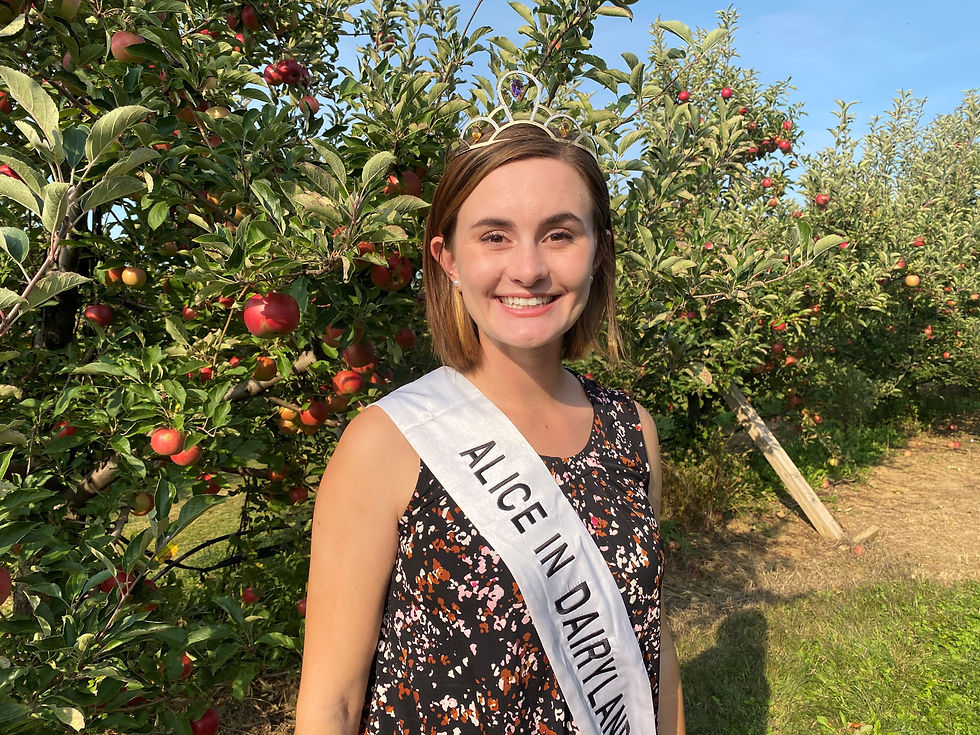Exploring the Diversity of Wisconsin Agriculture: December Specialty Crops
- Julia Nunes, 74th Alice in Dairyland

- Dec 7, 2021
- 3 min read
Updated: Jan 4, 2022

Wisconsin agriculture contributes $104.8 billion to our economy each year! From everything from growing to harvesting all the way to food processing, farmers across our state work hard every day to provide an abundance of delicious produce.
When most people think of Wisconsin agriculture, commodities like dairy, corn, and soybeans come to mind. While those commodities are a very important part of our state’s agriculture industry, there is so much more to Wisconsin agriculture. Wisconsin is a leading producer in many specialty crops, which are “fruit and vegetables, tree nuts, dried fruits, horticulture, and nursery crops (including floriculture),” according to the U.S. Department of Agriculture.
In the coming months, I encourage you to join me as I explore some of Wisconsin’s specialty crops.
As we approach the holiday season, I am highlighting two holiday staples: apples and Christmas trees!
Apples
Apples may be small, but they are a big part of Wisconsin. There are more than 300 commercial orchards in Wisconsin spanning 6,500 acres of land. They are located in 57 of Wisconsin’s 72 counties and offer a wide-variety of delicious apples all year long.

Wisconsin’s history with apples goes back to the 1800’s when apple seeds were brought to the state and planted by settlers. The first commercial apple orchards in Wisconsin were planted between 1830 and 1850, and these early orchards produced many different apple cultivars including some of local origin.
According to Wisconsin Apple Growers Association, Wisconsin apple orchards grow more than 300 different varieties of apples including Red Delicious, McIntosh, Johnathan, and Gala. All of these apples are medium to large size and perfect for enjoying in salads, baked goods, or pressed into warm apple cider.
Apples are a tasty and nutritious fruit that can be enjoyed all year long. Uniquely, they are one of the best sources of pectin, a type of fiber that helps prevent heart diseases and maintain cholesterol levels. In addition to their high levels of pectin, apples are a good source of vitamins and minerals and low in sodium.
According to the Wisconsin Apple Growers Association, apples ripen six to ten times faster at room temperature than at refrigerator temperature. After picking apples, place them into plastic bags to retain moisture and prevent them from absorbing odors from other foods. Store the bag of apples in your refrigerator crisper to keep them fresh. If you are storing sliced apples, sprinkle some lemon juice on them to prevent discoloration.
Christmas Trees
While we often think of Christmas trees around the holidays, farmers across Wisconsin are working hard all year long to make sure that you take home the perfect Christmas tree. Producers nurture seedlings to grown trees ready for harvest and, on average, it takes 15 years for these trees to be harvest ready. The most popular Christmas tree varieties grown in Wisconsin are Balsam Fir, Fraser Fir, White Pine, and Scotch Pine.

Christmas trees play an important role in Wisconsin’s agriculture industry. There are more than 850 Christmas tree farms across the state of Wisconsin and our state houses more than 23,300 acres of trees. Wisconsin harvests approximately 600,000 Christmas trees each year and, in 2017, ranked fifth in the nation in Christmas tree production.
These beautiful trees also provide many benefits to our environment all year long. They absorb carbon dioxide and, in return, release oxygen into the air. In fact, one acre of Christmas trees produces the daily oxygen intake for about 18 people. Additionally, they are often grown on land that would otherwise be subject to erosion if farmed with other crops and, unlike artificial trees, are 100% biodegradable. From bees and butterflies to bears and deer, tree farms are also provide a safe habitat for wildlife, birds, and insects.
After you have purchased a real tree, it is important to take proper care of it so it can look perfect on Christmas Day or beyond. The Wisconsin Christmas Tree Growers Association recommends using a tree stand with adequate water holding capacity to ensure your tree is able to absorb enough water. Additionally, they recommend that you keep your tree away from sources of heat and lower the room temperature where the tree is stored to help slow the drying process.
Once the holidays have past and you have to start taking down your holiday decorations, make sure to recycle your tree. Across the state, there are many programs and opportunities to recycle your Christmas tree. Some programs will even take your tree and turn it into mulch, compost, or even wood chips.







































